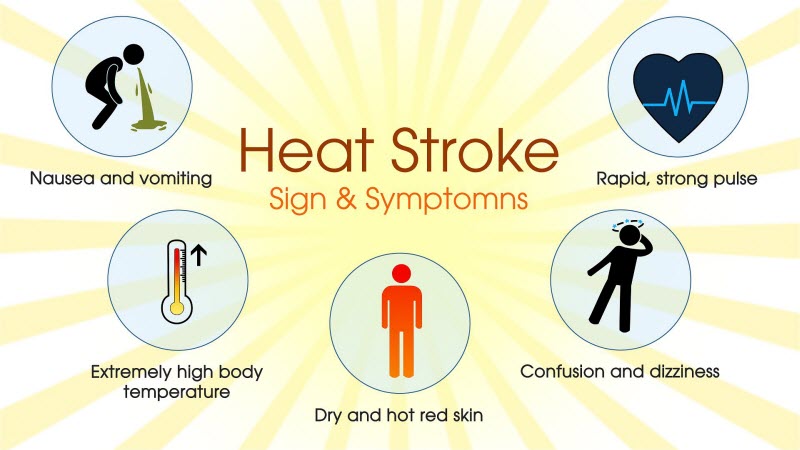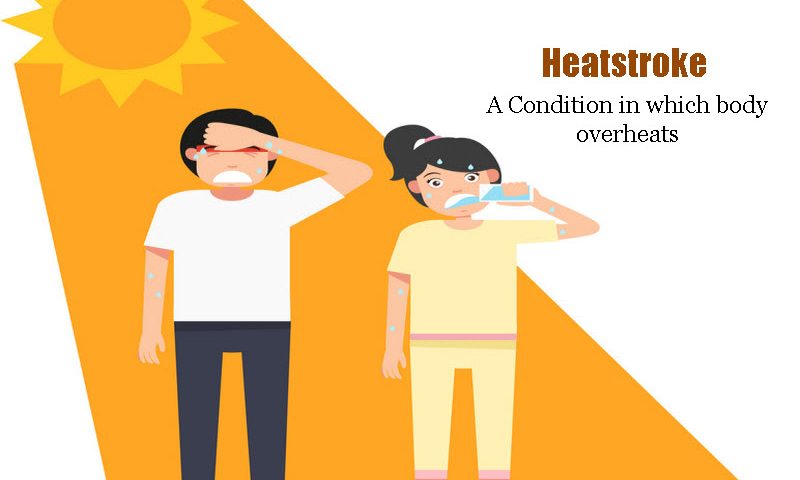This discussion includes the following information related to Heatstroke:
- Heatstroke
- Signs and Symptoms of Heatstroke
- Causes of Heatstroke
- Risk Factors for Heatstroke
- Complications of Heatstroke
- Tests and Diagnosis for Heatstroke
- Treatment and Drugs for Heatstroke
Heatstroke Definition

Heatstroke is a condition caused by your body overheating, usually as a result of prolonged exposure to or physical exertion in high temperatures. This most serious form of heat injury, heatstroke can occur if your body temperature rises to 104 F (40 C) or higher.
Heatstroke requires emergency treatment. Untreated heatstroke can quickly damage your brain, heart, kidneys and muscles. The damage worsens the longer treatment is delayed, increasing your risk of serious complications or death.
Signs and Symptoms of Heatstroke

Heatstroke symptoms include:
- High body temperature: A body temperature of 104 F (40 C) or higher is the main sign of heatstroke.
- Altered mental state or behavior: Confusion, agitation, slurred speech, irritability, delirium, seizures and coma can all result from heatstroke.
- Alteration in sweating: In heatstroke brought on by hot weather, your skin will feel hot and dry to the touch. However, in heatstroke brought on by strenuous exercise, your skin may feel moist.
- Nausea and vomiting: You may feel sick to your stomach or vomit.
- Flushed skin: Your skin may turn red as your body temperature increases.
- Rapid breathing: Your breathing may become rapid and shallow.
- Racing heart rate: Your pulse may significantly increase because heat stress places a tremendous burden on your heart to help cool your body.
- Headache: Your head may throb.
EMERGENCY CASE If you think a person may be experiencing heatstroke, seek immediate medical help. Call 911 or your local emergency services number.
Causes of Heatstroke

Heatstroke can occur as a result of:
- Exposure to a hot environment: In a type of heatstroke, called nonexertional or classic heatstroke, being in a hot environment leads to a rise in body temperature. This type of heatstroke typically occurs after exposure to hot, humid weather, especially for prolonged periods, such as two or three days. It occurs most often in older adults and in people with chronic illness.
- Strenuous activity: Exertional heatstroke is caused by an increase in body temperature brought on by intense physical activity in hot weather. Anyone exercising or working in hot weather can get exertional heatstroke, but it’s most likely to occur if you’re not used to high temperatures.
In either type of heatstroke, your condition can be brought on by:
- Wearing excess clothing that prevents sweat from evaporating easily and cooling your body
- Drinking alcohol, which can affect your body’s ability to regulate your temperature
- Becoming dehydrated by not drinking enough water to replenish fluids lost through sweating
Risk Factors for Heatstroke
Anyone can develop heatstroke, but several factors increase your risk:
- Age: Your ability to cope with extreme heat depends of the strength of your central nervous system. In the very young, the central nervous system is not fully developed, and in adults over 65, the central nervous system begins to deteriorate, which makes your body less able to cope with changes in body temperature. Both age groups usually have difficulty remaining hydrated, which also increases risk.
- Exertion in hot weather: Military training and participating in sports, such as football, in hot weather are among the situations that can lead to heatstroke.
- Sudden exposure to hot weather: You may be more susceptible to heat-related illness if you’re exposed to a sudden increase in temperature, such as during an early-summer heat wave or travel to a hotter climate. Limit activity for at least several days to allow yourself to acclimate to the change. However, you may still have an increased risk of heatstroke until you’ve experienced several weeks of higher temperatures.
- A lack of air conditioning: Fans may make you feel better, but during sustained hot weather, air conditioning is the most effective way to cool down and lower humidity.
- Certain medications: Some medications affect your body’s ability to stay hydrated and respond to heat. Be especially careful in hot weather if you take medications that narrow your blood vessels (vasoconstrictors), regulate your blood pressure by blocking adrenaline (beta blockers), rid your body of sodium and water (diuretics), or reduce psychiatric symptoms (antidepressants or antipsychotics).
- Stimulants for attention-deficit/hyperactivity disorder (ADHD) and illegal stimulants such as amphetamines and cocaine also make you more vulnerable to heatstroke.
- Certain health conditions: Certain chronic illnesses, such as heart or lung disease, might increase your risk of heatstroke. So can being obese, being sedentary and having a history of previous heatstroke.



